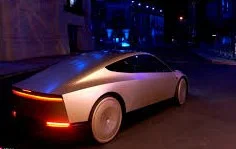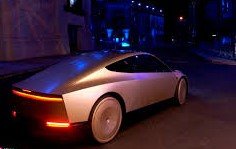Tesla’s Sporty, Two-Seater Robotaxi Design Puzzles Experts
Tesla has always been known for pushing the envelope when it comes to innovation. From electric vehicles (EVs) that have revolutionized the auto industry to cutting-edge battery technology, the company is no stranger to creating waves in the tech world. Recently, rumors and speculation surrounding Tesla’s new sporty, two-seater robotaxi design have puzzled industry experts. While self-driving cars are already a futuristic concept in and of themselves, Tesla’s potential move to introduce a small, sporty vehicle for its robotaxi service has sparked questions about both practicality and strategic direction.
What is Tesla thinking? Why would a company that leads the EV market choose such an unconventional design for a commercial robotaxi? In this article, we will explore the design, its potential implications, and why some experts are baffled by Tesla’s decisions.

A Glimpse into Tesla’s Robotaxi Vision
Tesla CEO Elon Musk has long teased the idea of a robotaxi network as part of his grand vision for the future of transportation. In 2019, Musk boldly claimed that Tesla would have a fleet of autonomous robotaxis on the road by 2020. While that prediction didn’t quite materialize on schedule, the idea still represents a key part of Tesla’s long-term strategy. The concept is simple: fully autonomous electric vehicles that can be summoned via an app, like an Uber, but without a driver. Owners of Tesla cars would also be able to add their vehicles to the fleet when not in use, essentially turning their cars into passive income-generating assets.
However, the notion of Tesla designing a robotaxi that’s not only autonomous but also a sporty, two-seater vehicle has taken many by surprise. This design choice challenges traditional concepts of what a commercial, shared transportation service should look like, as it doesn’t seem to cater to the mass market in the way other ride-hailing companies have approached autonomous driving.
Why a Two-Seater?
One of the major points of confusion for experts is Tesla’s decision to opt for a two-seater design. Traditional ride-hailing services, such as Uber or Lyft, focus on vehicles that maximize passenger capacity. More seats mean more paying customers per trip, which improves the economics of the business. In contrast, Tesla’s two-seater robotaxi offers a much more intimate, and arguably less practical, experience.
Some have speculated that the decision to go for a smaller vehicle could be tied to reducing costs. A two-seater would likely require fewer materials, be lighter, and therefore more energy-efficient. This could lead to lower operating costs per mile, which would be a significant advantage in the competitive robotaxi landscape. However, this would also mean that Tesla would be catering to solo travelers or couples, leaving out larger groups or families, which is a large portion of the ridesharing market.
Tesla’s Sporty Approach
Adding to the intrigue is the fact that the robotaxi isn’t just a two-seater but also reportedly has a sporty design. Tesla’s vehicles, particularly the Model S and Model 3 Performance, have already earned a reputation for being some of the fastest electric cars on the market. However, the decision to bring that performance-oriented ethos into a robotaxi seems out of place to many experts.
Robotaxis are typically seen as a form of public transportation, not luxury vehicles. In contrast, a sporty two-seater sounds like something aimed more at car enthusiasts than at passengers looking for a practical ride from point A to point B. Given that robotaxis are likely to operate in urban environments, speed and sportiness are not necessarily priorities.
So, what could Tesla be thinking? One possibility is that this sporty, two-seater robotaxi could appeal to a more niche market—those looking for a premium, thrilling experience rather than just a ride. This could position Tesla’s robotaxi service as a luxury offering, differentiating it from competitors like Waymo or Cruise, which have focused on larger, more functional designs.
Autonomous Tech: The Core Feature
Beyond the design quirks, Tesla’s robotaxi will heavily rely on its Full Self-Driving (FSD) technology, a software suite that has been at the center of much debate. Musk has made it clear that he believes in Tesla’s ability to achieve Level 5 autonomy, which means that the car can operate entirely without human intervention. While Tesla’s FSD technology has made significant strides, it’s still far from perfect, and regulatory approvals for full autonomy are still a major hurdle.
The robotaxi is expected to be the ultimate showcase of Tesla’s self-driving technology. A smaller, more agile vehicle could theoretically navigate crowded city streets more easily than a larger sedan or SUV. However, experts have raised concerns about how Tesla’s FSD technology will handle the complex dynamics of real-world traffic, particularly in urban environments, which are often unpredictable and chaotic.
Additionally, Tesla’s approach to autonomous driving, which relies on cameras and machine learning rather than Lidar technology (used by competitors like Waymo), has its critics. Some argue that the camera-based system is not sufficient for the level of accuracy needed for full autonomy, while others believe that Tesla’s data-driven, iterative approach will eventually pay off.
The Economics of the Robotaxi
Another puzzling aspect of the two-seater design is its potential impact on the economics of the robotaxi service. As mentioned earlier, a two-seater vehicle limits the number of passengers that can be transported per trip, which could reduce the overall profitability of the service. On the other hand, if Tesla’s robotaxi fleet is able to operate autonomously 24/7, with little downtime, the reduced capacity might not be as big of an issue as some might think.
In fact, autonomous vehicles eliminate the need for human drivers, which is one of the largest costs for traditional ride-hailing services. Tesla could offset the lower capacity by offering a more premium experience at a higher price point. After all, Tesla has always positioned itself as a premium brand, and a sporty two-seater robotaxi might fit within that broader brand identity.
Safety Concerns: A Major Factor
Safety is another key concern when it comes to autonomous vehicles, especially in the context of public transportation. Tesla’s FSD system has faced scrutiny over its reliability and safety, with several accidents being attributed to its autonomous features. A two-seater, sporty design could also raise concerns about the behavior of such a vehicle in accidents or high-speed scenarios. Autonomous vehicles are supposed to prioritize safety above all else, and a design that emphasizes sportiness might send the wrong message.
For regulators, safety will be the top priority in determining whether or not Tesla’s robotaxis will be allowed on public roads. Tesla will need to demonstrate not only the effectiveness of its FSD technology but also the structural safety of its smaller, sportier vehicle. This is especially important considering the higher risks associated with compact, lightweight cars in the event of a collision.
Expert Reactions: Confusion and Speculation
The news of Tesla’s two-seater robotaxi design has sparked a wide range of reactions from industry experts. Some are excited by the prospect of a smaller, more agile vehicle designed specifically for urban environments, while others are skeptical about its practicality in the ride-hailing space. Many are left scratching their heads, unsure of Tesla’s long-term strategy.
Karl Brauer, an auto industry analyst, noted, “Tesla has never followed the playbook, so it’s not surprising that they would take a different approach to the robotaxi concept. But I do wonder how a two-seater, sporty design fits into the broader context of shared transportation.”
Others have speculated that the design might be a stepping stone to a more practical robotaxi. By starting with a smaller, sporty vehicle, Tesla could be testing the waters and fine-tuning its autonomous technology before scaling up to a larger, more commercial fleet.
Conclusion: A Bold but Puzzling Move
Tesla’s rumored sporty, two-seater robotaxi design has certainly puzzled many, but it’s important to remember that the company has a history of defying expectations. While the design may seem unconventional, there could be method behind Musk’s madness. Perhaps Tesla is looking to create a new category of premium autonomous transportation, or maybe the two-seater is simply a testbed for future developments.
Whatever the case, one thing is certain: Tesla’s robotaxi plans are going to continue to be one of the most talked-about topics in the automotive and tech worlds. As the company moves closer to rolling out its autonomous fleet, we’ll likely get more answers—and even more surprises—along the way.
FAQs
- Why is Tesla designing a two-seater robotaxi?
Tesla may be focusing on reducing costs and creating a more energy-efficient vehicle for its robotaxi fleet, though this design limits passenger capacity. - How does Tesla’s robotaxi differ from competitors?
Tesla’s robotaxi is expected to feature Full Self-Driving technology and a sporty design, which contrasts with the more functional, passenger-oriented designs from competitors like Waymo. - Will Tesla’s robotaxi be fully autonomous?
Tesla aims for its robotaxis to operate with Level 5 autonomy, meaning no human intervention is required, though regulatory approvals are still needed. - Is the sporty design practical for urban environments?
The sporty design is more unconventional for a robotaxi, especially in crowded urban settings, where agility and space are often more important than speed. - When will Tesla’s robotaxi service launch?
While there is no confirmed launch date, Tesla has been actively developing its autonomous technology, with hopes of rolling out robotaxis in the near future.
Get Access to Fast And Reliable Hosting by Metacloude.com


